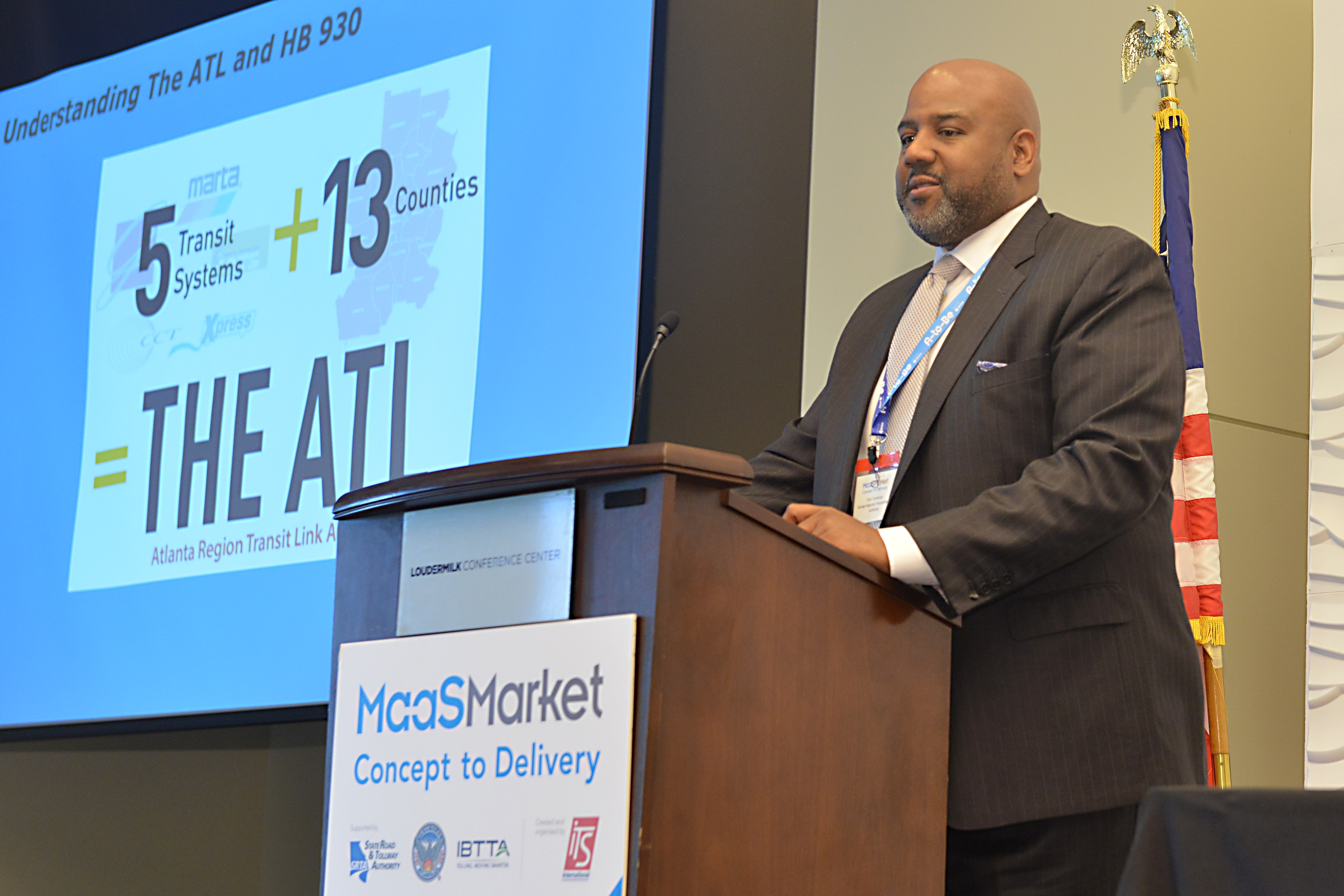
MaaS experts from around the world converged on ITS International’s MaaS Market Atlanta conference to talk about how MaaS can be implemented in the US. Andrew Bardin Williams had a front row seat
Transportation experts from around the world gathered in the US earlier this month to discuss the future of Mobility as a Service (
As a result, much of the conversation over the conference’s two days centred on how best practices from successful MaaS pilots and deployments in Europe and Asia could be adapted to fit the US market.
That’s not to say there was complete agreement: for instance, autonomous vehicles are often cited as one of the key game-changers in enabling mobility – but, in her presentation,
That is pertinent because it is no coincidence that the conference was held in Atlanta, one of the most congested cities in the world. The state of Georgia recently rolled out a new regional transportation authority that will sit on top of - and help manage - a dozen disparate transit agencies that currently service the metropolitan region. Called the Atlanta-region Transit Link Authority (ATL), the authority aims to address transportation and mobility issues from a regional - rather than a local city and county - perspective.
“We really set out to rethink how we connect disparate transit services to better serve the region and create a more connected, seamless experience for our citizens, and we hope that MaaS will be a big part of how we accomplish that moving forward,” said Chris Tomlinson (pictured above left), the executive director of ATL and member of the conference’s steering committee.
US barriers
Before MaaS can be rolled out in the Atlanta region or elsewhere in the US, the industry is going to have to figure out how to solve the unique problems in the US market.
Jonna Pöllänen from MaaS Global outlined three barriers to entry that her company would need to solve before entering the US market. They include: incomplete public transit options in an environment that focuses too much on the automobile; governance barriers resulting in city- and county-run transportation management rather than a regional focus; and a lack of technical building blocks - namely open data management platforms that MaaS providers like MaaS Global would need to tap into.
Pöllänen then listed three advantages that the US market provided: a culture of innovation; a willingness to embrace the service model; and a pro-business culture that would allow private service providers to flourish.
Importance of trust
A key theme of the conference was the importance of trust - both from a user and service provider perspective. Riders need to trust that a MaaS solution will get them to their destination anytime, anywhere - based on the best cost, optimal times and their individual preferences. At the same time, service providers who often see each other as competitors need to trust that route and fare information from other partners is accurate, that users are being encouraged to use their specific system if it makes sense for them - and that they are getting paid accordingly. Failure to establish this trust would bring the whole system down, argued several speakers over the two-day conference.
Jack Opiola, a transportation consultant, maintained that trust was based on three things: real-time data, a simple interface that provides a convenient platform for planning, ticketing and payment and opaqueness where the traveller is unaware of the complex behind-the-scene stakeholders and service provider partnerships. It truly has to be seamless and invisible to the riders, Opiola argued, in the same way that you don’t think about how water or electricity is delivered to your home: you trust that the commodity will be delivered. Mobility needs to be delivered in much the same way.
Getting transportation service providers - especially private operators - to join MaaS networks will take some convincing, said Anita Draa, global product director for
“The business models need to make sense for everyone involved,” she said.
Don’t be afraid to fail
Several MaaS case studies were presented over the course of the conference - most from Europe and India, though there were several from the US. The lesson they nearly all wanted to pass on was that agencies shouldn’t be afraid to fail.
Lee Woodcock (left), global product director for
Dr Vassilis Papayannoulis (right), vice president at Metropia, talked about a MaaS trial his company did in a small neighbourhood in Tucson with just two transit services - both bus routes. According to Papayannoulis, the lessons learned in this small trial helped Metropia learn how to best influence people’s travel habits.
ZED Digital touted its data aggregation platform that includes transit information in a single web interface. The platform includes a powerful analytics engine that would allow a transportation authority to monitor travel information and analyse behaviours for future planning.
Open data
Several MaaS providers took the stage and implored cities to provide open data - whether it is through a dedicated application programming interface (API) or a software development kit (SDK). This would allow agencies to stay out of the MaaS business altogether, argued Sampo Hietanen, CEO of MaaS Global - and allow MaaS providers to come in and implement a solution based on best practices honed from existing deployments in Europe and Asia. He did admit that transportation authorities should continue to maintain governance, acting as a guide and a partner for the MaaS provider.
“Provide us with APIs and open data, and a MaaS provider will come to your city,” he promised the crowd during a Q&A session after a presentation in which he predicted that the MaaS market would surpass $1 trillion globally by 2030.
Pushed to be more specific, Adrian Schonig, CTO of SkedGo, suggested that agencies provide both bulk data and APIs that supply a limited subset of what cities think providers need. Accurate trip planning is dependent on complete route and fare information - and that sometimes includes data that transit agencies don’t include in typical APIs, he said. He also asked that the data needs to adhere to MaaS Alliance standards - allowing providers to build a common framework for MaaS worldwide without having to go in and clean up data on a regional basis. Finally, Schonig encouraged cities to provide clean data that matches the real user experience - such as real-time route information for accurate route planning and rider information and bulk data for timetables and fare information.
Political will
There’s no doubt that MaaS would represent a massive sea change in how Americans move from point A to point B - and any disruption to car culture and the perceived freedom that individual vehicle ownership provides would be a tough battle. Politicians, never ones to rock the boat, would need to be convinced to go up against public perception that the car is the only answer and public transit is always second best - at least initially, until the benefits of MaaS as an alternative to urban car ownership were universally acknowledged.
Dr. Kari Watkins, a professor at Georgia Tech University, suggested that the industry needs to define the problem better to make inroads with the American public. Instead of singling out time and cost savings - two benefits that seem to work in the European market - cities should play up the safety and health benefits of MaaS.
She pointed to Centers of Disease Control and Prevention statistics that identified poor diet and lack of exercise as the two biggest causes of death in the US - a powerful data point that could get Americans to think about giving up their cars for healthier and more sustainable options such as walking, biking and public transit.
The way forward
ATL’s Tomlinson encouraged MaaS providers to work directly with cities and transportation providers rather than jumping into a market with the goal of being disruptive. Working closely with cities and showing them the benefits of a MaaS solution in the region would go a long way in helping them navigate the political landscape and regulatory issues.
The surprise of the two-day event was that true large-scale MaaS deployments in the US may not be as far away as many people think. Hietenan, the Finnish CEO of MaaS Global, challenged the room - and his own company - that he could deploy a MaaS solution in a US city within six months - albeit, as long as the city had the required variety of different transportation services and the ability to share transit information through APIs.
Abhay Jain (right), CEO of ActiveScaler, urged conference attendees to not think about MaaS from a one-size-fits-all perspective. His advice is for transit agencies and transportation authorities to take a local, regional and national approach to MaaS depending on their core mission to better service the individual needs of riders. He offered three alternatives from the ActiveScaler portfolio:
Local
The Tagsi app provides families in the US’s Bay Area with supervised rides to after-school activities such as music lessons and soccer practice using automated scheduling to ensure kids get where they need to go safely and on time.
Regional
Launched in India just a week before the conference, another ActiveScaler app called IMRide lets commuters book multimodal trips across heavy rail, light rail and even electric rickshaws throughout metro Delhi.
National
The company’s Destination to Destination (DtoD.in) MaaS offering provides a door-to-door service that includes planning and booking in one place. According to Jain, the MaaS service currently hosts more than 80,000 searches per day, resulting in 1 million routes and hundreds of bookings.












